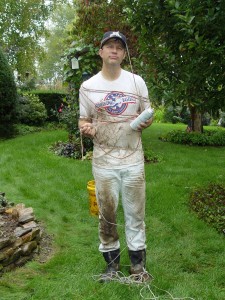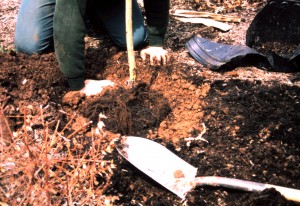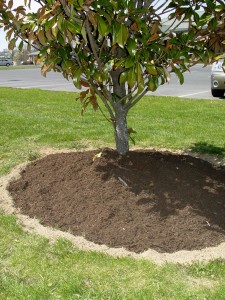Seven Gardening Mistakes to Avoid
May 13th, 2014
This is the year everything goes just fine in the ol’ landscape, right?
Well, don’t count on everything. Every year has its own new set of curveballs. But things ought to go better if you at least avoid these seven common gardening miscues as the 2014 season finally gets under way:
1.) Not improving lousy soil. Most of us aren’t blessed with good enough soil that we can just dig a hole and plant. Our “soil” is more like clay, shale, rocks and/or compacted subsoil.
Before planting, improve your planting bed by working 1 or 2 inches of organic matter into the top foot of loosened existing soil.
Good choices are compost, composted leaves from the borough or township, mushroom soil, rotted horse or cow manure and/or bagged planting mix or peat moss from the garden center.
You’ll end up with slightly raised and well drained beds that plant roots adore.
2.) Planting too closely. This includes planting plants too closely to one another as well as too closely to the house.
Determine the mature width of your new plant and space according to that – not its current size.
Spacing rule of thumb: Add mature widths together and divide by two, then plant no closer than that. (Example: 8-foot holly beside 4-foot spirea. 8+4=12, divide by 2, equals 6-foot minimum spacing.)
To space from houses, simply divide the mature width in half. (Example: 8-foot holly should go no closer than 4 feet from the house.)
3.) Too-deep planting. This one’s a major killer of trees.
Before planting a new tree, identify its “root flare” (the area at the base of the trunk where it begins to slightly widen).
Plant so that this flare is just above ground.
Be aware that potted and balled-and-burlapped trees are often already planted too deeply in their pots and bags. You may need to excavate soil or mulch to expose the flare.
4.) Poor planting practices. Go wide but not overly deep with those holes when planting trees and shrubs.
Most roots spread out within the top 1 to 2 feet of the surface as opposed to going straight down deeply as most novices think.
Dig holes for your trees and shrubs three to five times as wide as the root ball but only as deep as the root ball (so the soil doesn’t settle and cause the rootballs to sink).
Fray out circling roots and watch the planting depth (root flare above ground for trees and shrubs, same level as in the pot for flowers). Tamp soil and water well after planting.
5.) Mulching miscues. You can overdo it or underdo it.
Too much mulch can cause the same problems as planting too deeply. Too little won’t stop weeds or retain moisture very well.
Especially be careful not to pack mulch up against the stems and trunks of plants. That can rot the stems and bark and possibly kill the plants.
Two to three inches of organic mulch (i.e. bark mulch, chopped leaves, shredded hardwood) is ideal around trees and shrubs. Inch to two inches is fine around flowers.
6.) Watering blunders. Your goal is to keep the soil consistently damp (never soggy) all around the root ball and to just below it. That encourages roots to grow out toward the water.
The best way to gauge the amount needed to do that: Water slowly enough that the water soaks in instead of runs off for the time you think is right. Wait 10 or 15 minutes and use a stick or probe to go down beside the root ball to see how deeply the soil has been moistened.
If it’s excessively wet, try a little less next time. If it’s not wet deeply enough, you’ll need to water more or for longer.
Once you know the time and amount that’s just right for that bed, deliver it according to weather and plant size.
Plants with bigger rootballs, such as trees and shrubs, are best soaked deeply once or twice a week. Vegetables, annual flowers and newly planted perennials are best watered 2 to 3 times a week in hot, dry weather since their roots are shallower and closer to the surface (which dries out fastest).
You won’t need to water as much when it’s cooler and cloudier and probably not at all if a soaking rain does the deed for you.
Pay more careful attention to regular watering when the plant is young… before roots have had a chance to develop and “mine” water effectively from a wider area.
7. Picking problem-prone plants. Just because a plant is commonly planted doesn’t mean it’s a great choice.
Some of the most trouble-prone plants also happen to be some of our most used, such as dwarf Alberta spruce (mite magnets), azalea (hates compacted, alkaline soil and hot, dry, sunny sites), mugho pine (likely to get scale insects) and American dogwood (prone to boring insects and powdery mildew and anthracnose diseases).
On the other hand, little-known and under-used choices such as witch alder, summersweet, oakleaf hydrangea and winterberry holly seldom run into any problems.
The lesson is that not all plants are created equal.
Do some homework up front, and you’ll save lots of work, money and effort later.
For starters: Check out my list of recommended plants for central Pennsylvania. You’ll find details and pictures of some 300 choices on the Plant Profiles page of my website.
For even more choices and details, download (or send for) the 2014 edition of my 18-page booklet, “George’s Survivor Plants for Central Pa.” It can found on my Helpful Info You Can Buy page.










